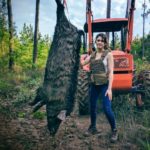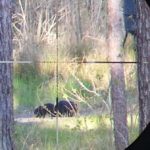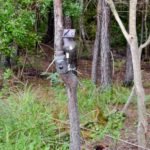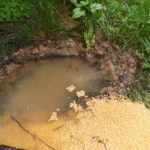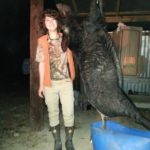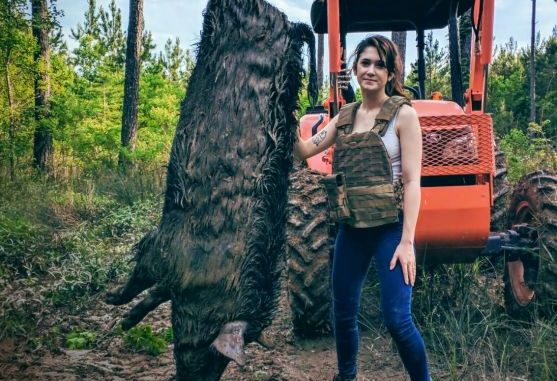
Feed, feed, and feed some more to take down record number – and size – hogs.
The big guy sat down fluidly and easily in the ground blind with his Weatherby Accumark Custom rifle over his knees.
For his 275 pounds, he was nimble, if not spry.
Rich Shiree would have preferred hunting in one of his ladder stands, but to accommodate two of us, a ground blind it was. Shiree was set up in Livingston Parish, near where agricultural flatlands met wetland piney woods that in turn, segued into the Maurepas swamps.
A few days before, his wife Laney had killed a 543-pound hog in the same area and more hogs were pigging out on the piles of corn he had put out to attract them. He was hopeful, but as in all hunting, there were no guarantees.
It was 7:30 p.m., still with plenty of daylight, but easing off the stifling heat of the afternoon. After we settled in, I asked how they weighed Laney’s monster hog.
“We hoisted the hog with a tractor’s front end loader, but our game scale only went to 500 pounds,” he grunted. “Hogs larger than that we have to weigh in 2 pieces, the skinned body separate from the rest of it.
“The biggest one I killed so far was 592 pounds. I have personally killed five heavier than 400 pounds and the other members of my family have killed another five. I’m a big hog hunter; I like big hogs,” he chuckled.
Perhaps I looked incredulous, because he went on. “There are big hogs anywhere south of the I-10/I-12 corridor. Further north are a lot more of what I call ‘rooters,’ full-grown hogs weighing under 150 pounds.
“I feel that the feral hogs in south Louisiana are fewer generations removed from farm hogs. A 400-pound boar hog down here will have tusks 2 inches long. A 200 pound rooter will have 4-inch tusks, easy.”
Further evidence to support his theory is that half of the piglets he sees in Livingston Parish are black or brown, rather than striped. Striping is a characteristic of “Russian blood.”
As the damp dusk began to settle around the big man, he narrated that his hunting life went to the hogs in 2013, when he decided to join a deer lease near the Tickfaw River. “There were very few deer,” he said, “but a lot of hogs. The landowner was all for us killing the hogs.
“We originally started trying to weed out the hogs so we could get some deer. We set up to hunt at night and Laney, my two sons Pierce and Dayton, and I came in with three hogs from four stands.
“We sat up in the camp talking about how much fun it was. Then we realized that we never did that for deer hunting. My sons asked, ‘Can we do it again?’”
The quartet killed 36 hogs the first two months of hunting; 24 of them were heavier than 250 pounds. He claimed Laney killed half of them and even once killed two with one shot.
“After that deer season, we went into full-time hog hunting all year,” he said. “I don’t hunt deer in Louisiana now. Hog hunting is a lot more fun.
“Night hunting is an enjoyable thing — quiet, peaceful, and cool. It’s unique. Nothing else in North America that weighs over 100 pounds can be hunted at night.”
But, he cautioned, strict rules must be obeyed for night hunting. He recommended that a prospective night hunter should read the Louisiana Department of Wildlife and Fisheries rules and check with their local sheriff’s office, as well.
Shiree hunts hogs 200 nights a year and shares the meat they don’t keep for sausage with friends. “We have a list of people who want pork. When we shoot a hog, we start texting the list, although often we will have someone who has requested a hog ahead of time.
“We’ve never had trouble getting rid of one.
“If you compare one of these hogs to one butchered in a butcher shop, you can’t tell the difference. They are corn-fed because we constantly feed them corn. They are eating the same food as the deer are.
“I’ve killed antelope covered with boils and infested with bugs. These hogs are a cleaner meat.”
Shiree became silent as light faded.
Immediately after dark a chorus of frogs started singing. By 8:45 p.m., things that go “bump” in the night started stirring.
When the floodlight near the bait came on, it surprised me. I guess that I expected a bright glow. Rather, it was a dim green umbra, essentially just a lighter spot in the darkness.
“How can he see anything,” I asked myself.
By 9 a.m., I began to wonder how I get myself into these predicaments. He kept insisting that the light was on. “See it? Right there! See it?”
I couldn’t see jack-anything. Just several shades of darkness!
Ten minutes later, a flash of light popped. “There,” he said with some satisfaction. “That is the light reflecting off a black pig.
“Hear them squealing? They are in the woods coming out. They usually come out about 9:30 or 10 p.m. Laney (who was in a nearby stand) will probably shoot first.”
Ten minutes later, he grunted, “Smell that? It smells like burnt rubber. It’s a big boar urinating. You can’t mistake that.”
I didn’t smell anything; I still couldn’t see anything either. It was humid and dank — like breathing under a wet blanket.
“See it?” He touched my shoulder.
I still didn’t see anything.
“Something just blocked the whole light,” he murmured.
Heck, I couldn’t see the light at all. I was conscious of his breathing next to me. All else was silent.
He picked up his rifle several times to peer through the scope to take advantage of its light-gathering qualities. Each time, he put it down without squeezing the trigger.
There! There! I saw flashes of light off a black hide. Shiree threw the beam of his powerful flashlight on the spot. I barely made out a black smudge.
“Let’s wait a minute,” he hissed. “He’s not the one I want.”
“How could you even hit it,” I whispered.
“Are you kidding?” he questioned. “That would be an easy shot. His head is as big as a 5-gallon bucket.”
“You got to see the bucket to shoot it,” I thought to myself.
“Let’s wait,” he repeated. “That pig ain’t going nowhere.”
It was 9:45 p.m.
“Oh well,” I slumped back in a humid funk.
The hog never came back.
At 10:30 p.m., he flicked on his flashlight. “Let’s go. I’ll get him tomorrow night.”
Bait, bait, and more bait
For Rich Shiree, corn is where it’s at.
“Hogs will come from miles around to feed. Baiting works! You can really pull them in with corn. And hogs are everywhere!
“I tried putting feed out 250 yards from the Mall of Louisiana in Baton Rouge and guess what? Three hogs appeared on the feed in 4 days.
“In Baton Rouge!”
The biggest factor in using corn for bait, said Shiree is to use lots of it. Hogs will come to feeders, but feeders don’t work well for his technique. For a feeder to drop enough feed, it would have to be running constantly.
Shiree outlined his baiting strategy. “Pick a site with at least one side near heavy cover because hogs are skittish in the open. Begin the site by dumping 100 pounds of corn on the ground.
“Hogs are where you want them to be. If there is feed on the ground, they will find it. Check the site every day. If the corn is being eaten, we start hunting the site.”
Shiree stresses that it is important to set up a light post and camera at the same time that feed is first placed on the site, so that there are no later changes to the site that will disturb the hogs once they start using the bait pile.
“A key thing,” he emphasized, “is to never let the feed run out. If it runs out, you will lose pigs. They will scatter.
Shiree often “sours” his corn bait. He fills 5-gallon buckets half full of corn and tops them off with water. He lets this mix soak for 2 or 3 days in the summer or 5 to 6 days in the winter.
When it smells sour, it is ready to use, he said. “Pigs are a scent animal and sour smells attract them.
“Another plus is that souring keeps deer off of the corn, exactly opposite the problem that deer hunters have with feeding corn.
“Souring is good to first attract hogs to a bait site. Once they come, they will return again and again and can be fed dry corn.
Hog hardware
Very little equipment is needed for Shiree’s style of hog hunting: lights, cameras, stands, and a rifle.
His choice of lights are inexpensive (about $20) solar floodlights. When the sun goes down the lights come on. He mounts the lights on a 10-foot metal T-post, the kind used for barbed wire fencing, or a small tree.
“The pigs get used to the light because they come on every night,” he said. “Once they get used to it, the light means nothing to them.”
Shiree likes to aim the light to shine to hit the ground behind the corn pile, as viewed from the stand. “In that position, it gives you a distinct silhouette of the hog and makes for better shooting at night.
“Plus the hogs aren’t in direct light and are more comfortable at the bait site.”
Shiree likes to mount his game cameras approximately 10 yards from the bait pile. The camera should be mounted 3 feet from the ground to prevent the hogs from rubbing it off the T-post or tree.
Although he will occasionally use a ground blind, his current preference is for 2-man metal ladder stands. “When we first started this, we sat in lawn chairs in the open,” he laughed out loud, noting that the feeding hogs with the light in their eyes cannot spot a hunter.
But he was quick to add that hunting from a ladder stand is safer than hunting on the ground. “Hogs, especially large males, are predators and can be dangerous. I’ve had them run into a ladder stand, which is why I secure them. Hogs are powerful and mean.
Shiree buries the base of each ladder 16 inches deep in the ground and double straps it to the tree with 1,200-pound cargo straps.
A variety of rifle calibers can be used to hunt hogs, said Shiree. He recommends at least a .308 or larger. His personal favorite is a .257 Weatherby Magnum.
“Large, mature boar hogs have armor, a callus that covers their sides over their vital organs,” he explained. “The armor is there to provide protection from other hogs, but it is difficult for less powerful rifles to penetrate.”
He considers a scope to be a necessity for night time hog hunting. A scope with an illuminated reticle is best. “You want the crosshairs to light up,” he said. “Black crosshairs on a black pig silhouette makes accurate shot placement difficult.”
He noted that another option is the use of a night vision scope that would allow hunting without the use of lights.
Missing opportunities
Rich Shiree has strong opinions about hog hunting.
“The hunting of hogs as a sport should be promoted! I would like to see more attention given to them, rather than writing them off as a nutria. They are not nutria!”
Shiree hunts hogs in Louisiana from February to August of each year. During the “off months” he travels North America to hunt for deer.
“Promotion of hog hunting as a sport will help control their populations — something that isn’t happening now. Deer hunters feed hogs and they aren’t killing them.
“Most of them don’t want to mess up their deer hunting. The way we hunt, you can wipe out an entire line of hogs.”
Shiree calls the belief that hogs will force deer out of an area “pure baloney,” adding “deer and hogs will stay near the feed site at the same time but take turns feeding. One feeds while the other waits within 50 feet of the feed.
“We have many photos over a corn pile of deer following hogs 3 minutes after the pigs have left it.”
In spite of enjoying hunting for hogs, Shiree is quick to admit the negative impacts of feral hogs. “Mature hogs will not fight a deer, but they will actively kill newly born fawns.
“They will also wipe out a food source. Without food, deer can’t thrive.
“You only choice is to kill the hogs. Heavy feeding and night hunting are the most effective way of doing that.”
